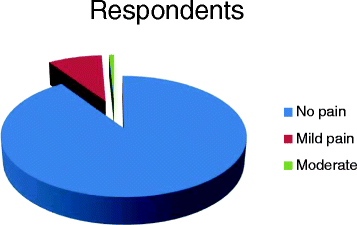Transvaginal Sonography: perception and attitude of Nigerian women
- PMID: 28750613
- PMCID: PMC5532778
- DOI: 10.1186/s12905-017-0413-z
Transvaginal Sonography: perception and attitude of Nigerian women
Abstract
Background: To assess the attitude to and perception of transvaginal sonography (TVS) among Nigerian women of mixed educational status in order to ascertain factors that may prevent them from submitting to TVS when recommended.
Methods: A Cross-sectional survey was adopted for the study. In all, one missionary, one government and eight private hospitals were enlisted. The instruments for data collection were visual analogue scale (VAS), to ascertain patients' pain/discomfort experience, and a researcher-developed semi-structured questionnaire. The level of pain/discomfort on the VAS was categorized into four on a scale of 100. The categories were: 0-5 (no pain), 6-40 (mild pain), 41-74 (moderate pain), and 75-100 (severe pain).
Results: Majority (50.6%) of the respondents who attained secondary education had positive attitude to TVS. Also majority of the respondents (63.1%) preferred female sonographers. Majority of the respondents (54.1%) perceived TVS as not embarrassing, 78% did not consider it stressful, 96.9% reported that the sonographers were professional, 46.7% felt that a chaperon was needed, 98.4% reported there were enough privacy and 84.7% reported they needed prior information. Most of the respondents (82%) were willing to consent to TVS in future, 90.5% reported no pain, 8.6% reported mild pain/discomfort and 0.9% reported moderate pain.
Conclusions: Majority of our respondents had positive attitude to TVS and were willing to consent to TVS in future, hence it was acceptable to them. It was however observed that acceptability increased with increasing academic status.
Keywords: Attitude; Nigeria; Perception; Transvaginal sonography; Women.
Conflict of interest statement
Ethics approval and consent to participate
Ethics approval and consent to participate was obtained from the Research and Ethics Committee of University of Nigeria Teaching Hospital, Enugu. Informed consent was obtained from each of the participants.
Consent for publication
Not applicable.
Competing interests
The authors declare that they have no competing interests.
Publisher’s Note
Springer Nature remains neutral with regard to jurisdictional claims in published maps and institutional affiliations.
Figures
Similar articles
-
Assessment of women's attitude to and perception of transvaginal sonography in Nigeria.Technol Health Care. 2017 Aug 9;25(4):797-802. doi: 10.3233/THC-170842. Technol Health Care. 2017. PMID: 28436409
-
Acceptance of transvaginal sonography by postmenopausal women participating in the United Kingdom Collaborative Trial of Ovarian Cancer Screening.Ultrasound Obstet Gynecol. 2013 Jan;41(1):73-9. doi: 10.1002/uog.12262. Epub 2012 Dec 11. Ultrasound Obstet Gynecol. 2013. PMID: 22791597 Clinical Trial.
-
Transvaginal sonography is feasible and universally acceptable to women in Ibadan, Nigeria: experience from the 1st year of a novel service.Ann Afr Med. 2015 Jan-Mar;14(1):52-6. doi: 10.4103/1596-3519.148740. Ann Afr Med. 2015. PMID: 25567696
-
Transvaginal sonography of normal pelvic anatomy.Radiol Clin North Am. 1992 Jul;30(4):663-75. Radiol Clin North Am. 1992. PMID: 1631275 Review.
-
[Performances and place of sonography in the diagnostic of endometriosis: CNGOF-HAS Endometriosis Guidelines].Gynecol Obstet Fertil Senol. 2018 Mar;46(3):185-199. doi: 10.1016/j.gofs.2018.02.026. Epub 2018 Mar 12. Gynecol Obstet Fertil Senol. 2018. PMID: 29544709 Review. French.
Cited by
-
Mid-trimester cervical length not associated with HIV status among pregnant women in Botswana.PLoS One. 2020 Mar 11;15(3):e0229500. doi: 10.1371/journal.pone.0229500. eCollection 2020. PLoS One. 2020. PMID: 32160214 Free PMC article.
-
Intimate patient examinations: The awareness, acceptance and practice preference of transvaginal ultrasound scan among women in a South-southern State of Nigeria.J Family Med Prim Care. 2019 Jan;8(1):109-114. doi: 10.4103/jfmpc.jfmpc_207_18. J Family Med Prim Care. 2019. PMID: 30911489 Free PMC article.
References
-
- Eze CU, Okaro AO, Nwobi IC. Women’s perception of transvaginal sonography in a tertiary hospital in Nigeria. Pakistan J Med Res. 2008;47:83–86.
MeSH terms
LinkOut - more resources
Full Text Sources
Other Literature Sources


